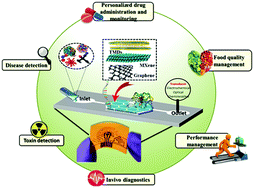Microfluidic sensors based on two-dimensional materials for chemical and biological assessments
Abstract
There has been an exponential increase in the number of studies of two-dimensional (2D) layered materials for sensing applications since the isolation of graphene in 2004. These materials serve as a supporting substrate and an active sensing element in a variety of health care and environmental applications due to their exceptional and frequently tunable physical, optical, electrical, and electrochemical capabilities. Microfluidic sensors are a relatively new technology that shows promise in health care and environmental applications due to quick response, inexpensive and highly sensitive analysis with high yield. Due to their appealing electrical and electrochemical properties with a variety of structural features and fabrication processes, 2D materials are a good contender for microfluidic sensor applications. As a result, these two-dimensional material-based microfluidic devices can provide a well-controlled microenvironment for both low-cost point-of-care analytics and advanced chemical/biological analysis. Different 2D materials for microfluidic sensors and their possible use in various health care and environmental applications including wearable sensors are critically addressed in this review. Finally, the challenges and prospects for the future of 2D materials in terms of commercial challenges and long-term sustainability are examined.

- This article is part of the themed collection: Recent Review Articles


 Please wait while we load your content...
Please wait while we load your content...